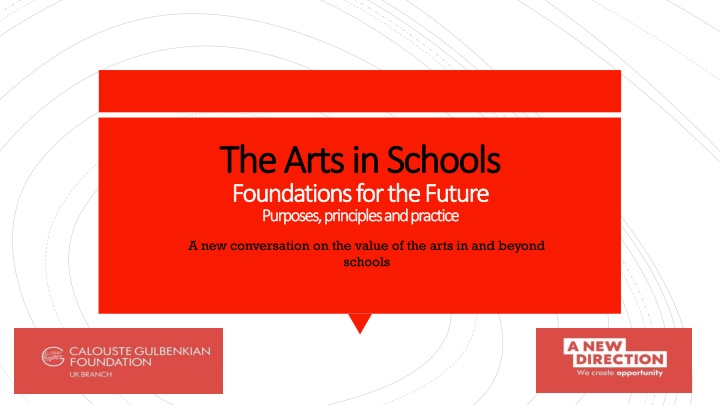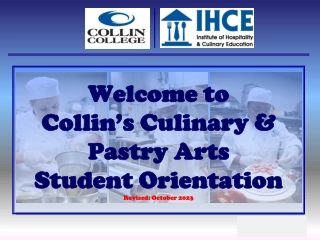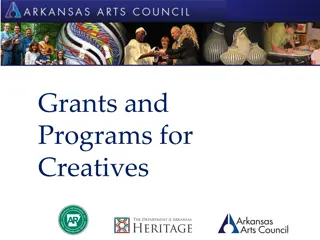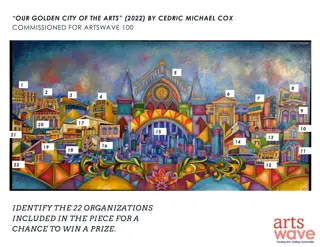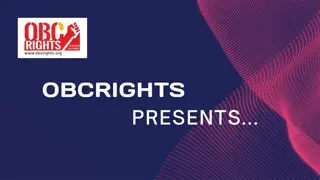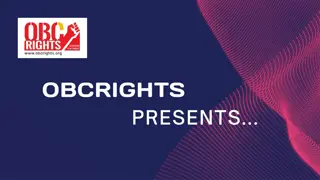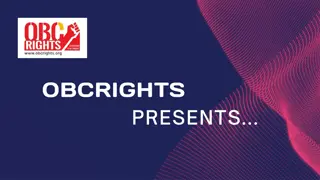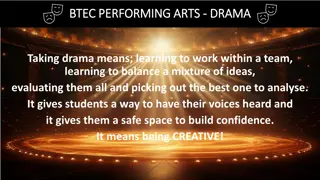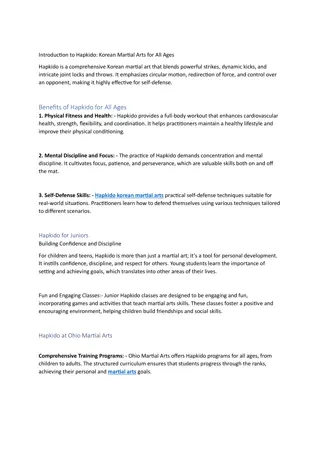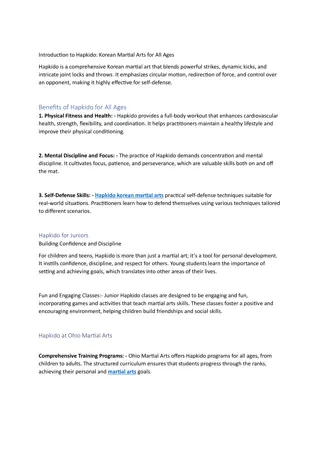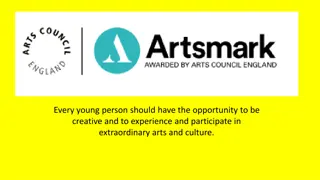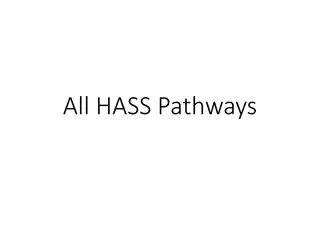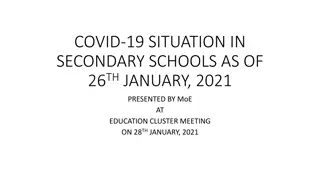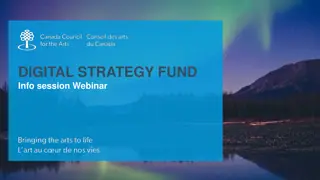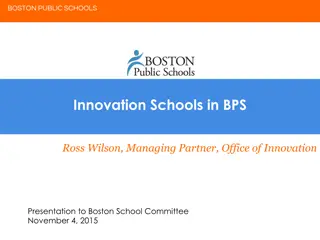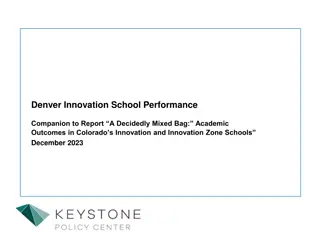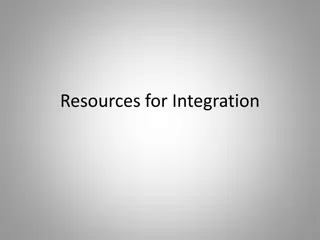The Arts in Schools
Unveiling the significance of arts in educational settings, this dialogue highlights the value of integrating artistic practices within and beyond schools. Delve into the purposes, principles, and practical applications that underscore the transformative role of arts in shaping the future. Engage in a new conversation that emphasizes the enduring importance of arts education for fostering creativity and innovation in young minds.
Download Presentation

Please find below an Image/Link to download the presentation.
The content on the website is provided AS IS for your information and personal use only. It may not be sold, licensed, or shared on other websites without obtaining consent from the author.If you encounter any issues during the download, it is possible that the publisher has removed the file from their server.
You are allowed to download the files provided on this website for personal or commercial use, subject to the condition that they are used lawfully. All files are the property of their respective owners.
The content on the website is provided AS IS for your information and personal use only. It may not be sold, licensed, or shared on other websites without obtaining consent from the author.
E N D
Presentation Transcript
The Arts in Schools The Arts in Schools Foundations for the Future Foundations for the Future Purposes, principles and practice Purposes, principles and practice A new conversation on the value of the arts in and beyond schools
Supported by the Calouste the former Arts Council England-funded Bridge organisations Calouste Gulbenkian Gulbenkian Foundation Foundation and The Arts in Schools Published by A New Direction A New Direction, an award-winning non- profit working towards a world where all children and young people achieve their creative potential Who are we? Authors: Sally Bacon OBE and Pauline Tambling CBE, independent consultants The Arts in Schools report and associated resources are now available on the Cultural Learning Alliance Cultural Learning Alliance website: www.culturallearningalliance.org.uk www.culturallearningalliance.org.uk
The Arts in Schools To read and revisit the seminal 1982 Calouste Gulbenkian report, The Arts in Schools The Arts in Schools, to test its relevance, and to reflect on what has happened to the arts in schools in the decades since. What the project set out to do To consider the place of the arts as part of the school curriculum in the maintained sector of education, and to make recommendations. Terms of reference for the 1982 The Arts in Schools Inquiry
Published a think piece (May 2022) think piece and 40 40- -year timeline year timeline The Arts in Schools Convened nine online roundtables nine online roundtables on the original themes of the report with more than 300 participants (June-October 2022) What the project achieved 2022-2023 Set up and ran a young people s group young people s group, resulting in creative responses (July-September 2022) Published a series of blogs a series of blogs on the themes of the roundtables (September 2022-January 2023) Published 24 case by and with schools (February 2023) 24 case- -studies studies of excellent arts education practice Published the final report, an executive summary and updated the final report, an executive summary and updated 40 40- -year timeline year timeline (March 2023)
In 1982 there was no National Curriculum, no Ofsted, no SATs, no academisation. Schools were run by LEAs The Arts in Schools There was no internet, no YouTube, no Twitter, no Facebook, no Instagram, no TikTok, no AI It was before devolution: education and skills, and the arts, are now devolved to the UK nations The world has changed There was no definition of the creative industries, and very few arts organisations had learning and participation teams It was at the very beginning of professional arts organisations having learning teams In the 40 years since The Arts in Schools there have been 22 Secretaries of State for Education with only eight being in post for more than two years. There were six postholders between 2020 and 2022, with astonishingly five in 2022 alone.
The Arts in Schools It is still possible for schools to offer a rounded arts curriculum. There is some excellent practice There is some excellent practice across the country which is celebrated in the project s accompanying bank of 24 case studies Two important things to state at the outset But to provide a good arts education within the curriculum and beyond now takes brave brave and leaders and teachers leaders and teachers because much of what s happening in education mitigates against it and courageous courageous school school The 1982 inquiry concluded with the central question about the purposes of schooling, the balance of the curriculum and about the whole character of education in Britain. Four decades on we have concluded that this central question is as pertinent, if not more pressing, today as it was in 1982.
1 in 5 childrenhave probable mental health problem (NHS) 4.2 million children and young people in the UK growing up in poverty; 1 in 5 children eligible for free school meals (Child Poverty Action Group) 1.7 million pupils regularly absent from lessons; 100,000 are so-called ghost children have disappeared from the education system altogether (Centre for Social Justice) The current context UK ranked lowest out of 24 European countries for the proportion of 15-year-olds with high life satisfaction (PISA) State school trips are being cut in the face of the cost-of-living crisis, down by 68% in the poorest schools (NFER/Sutton Trust) Arts subjects were hit particularly hard during the pandemic; arts take up is down 40% since 2010
1. 1. Arts subjects and experiences make a positive difference to Arts subjects and experiences make a positive difference to learning and personal outcomes learning and personal outcomes for children and young people, providing them with skills for life and skills for work. The Arts in Schools 2. 2. Despite this, there is a lack of value ascribed to them within the Despite this, there is a lack of value ascribed to them within the state education system in England state education system in England in which they are devalued and down-graded due to accountability measures that exclude them, and by a system focused on exam success as opposed to whole child development. And access is not equitable: we have a two-tier system, with the arts more highly valued in independent schools. The report has three headline findings 3. 3. The schooling system itself is still running on outdated policies The schooling system itself is still running on outdated policies without a clear purpose without a clear purpose for what schools are equipping young people with, or why. The report s analysis of the arts in schools within this wider context reveals why change is necessary and how it is possible. We describe the arts as being full spectrum subjects from solace to skills, from empathy to experimentation providing memorable experiences and supporting the development of critical thinking, self- expression, independence, initiative, collaboration, compassion, achievement, and creative freedom.
1. 1. Rationale: Rationale: clear purposes for schooling and a coherent vision for subject areas, with curriculum linked to purposes The Arts in Schools 2. 2. Parity of esteem: Parity of esteem: equal status for arts subjects with other curriculum areas, within a broad and balanced curriculum Five core policy Five core policy principles are principles are identified to underpin identified to underpin the arts in schooling the arts in schooling 3. 3. Including every child: Including every child: an access entitlement built on inclusion and equality 4. 4. Whole child and a rounded learning experience: Whole child and a rounded learning experience: educating for personal development and wellbeing, not just academic attainment 5. 5. Education for now: Education for now: educating for the importance of the present, as well as for the future The original report presented the case for education for the present as well as the future (the world of work), and for schooling to be about more than academic achievement, and importantly for all children.
1. 1. Breadth: Breadth: exposure to all art forms and a breadth of work and experiences The Arts in Schools 2. 2. Balance: Balance: between knowledge and skills and five core and five core provision principles to provision principles to enable a school to enable a school to become become arts arts- -rich 3. 3. Inclusion: Inclusion: embracing the needs of all children 4. 4. Relevance: Relevance: reflective of the world in which children live and will work rich 5. 5. Learner voice: Learner voice: listening to children and young people Representation in all that happens in schools is crucial: across course materials, texts chosen, artists studied, composers selected, and performances, stories and histories experienced. To be fully engaged children need to see themselves represented in the arts they experience.
The Arts in Schools 1. 1. A national conversation to consider and define new A national conversation to consider and define new purposes for schooling purposes for schooling 2. 2. A n A new curriculum area ew curriculum area the Expressive the Expressive A Arts rts The report makes 10 The report makes 10 recommendations: recommendations: scaffolding for the scaffolding for the future future 3. 3. Changes to how we assess arts subjects Changes to how we assess arts subjects 4. 4. curricular arts as additional curricular arts as additional Creating an arts entitlement within the school day, with Creating an arts entitlement within the school day, with extra extra- - 5. 5. Representation and relevance Representation and relevance Equity has to sit side by side with quality on the basis that it s still always the case that the poorest children get the worst deal when it comes to arts and culture education participation.
6. 6. T Teacher and learner agency eacher and learner agency The Arts in Schools 7. 7. Improved and evidence Improved and evidence- -based narrative case based narrative case- -making making The report makes 10 recommendations: scaffolding for the future 8. 8. Support for the arts in schools from the professional arts Support for the arts in schools from the professional arts sector sector 9. 9. Schools at the heart of their communities Schools at the heart of their communities 10. 10. Aggregating the findings of reports calling for education Aggregating the findings of reports calling for education system change system change Professor John Last has described the fundamental flaw in the logic that says to count is to become economically productive, but to create is not .
Read the report, the summary, the Timeline Share with colleagues: with colleagues: with school and MAT leaders and with governors; with parents; with the CEOs, chairs and boards of arts organisations; and on social media The Arts in Schools Share on social media: on Twitter, Facebook, Instagram or LinkedIn. Post a message with a link to the full report or executive summary to your followers. Ideally tag specific people #ArtsinSchools What next? A time for change Read the CLA Manifesto Asks for GE2024 which distill the report s asks; share these with colleagues; tell your local candidates what changes are needed; back the asks on social media; sign up to receive all the latest arts education news. www.culturallearningalliance.org.uk www.culturallearningalliance.org.uk
